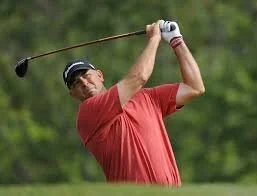Tom Friedman, Golfer
We head to the first tee on a perfect day. This is all business, serious business for Tom Friedman, the Pulitzer Prize winning author, New York Times columnist and an expert on international affairs. There will be no raking away four foot putts, no improving unlucky lies, no feeling sorry if someone is off their game. This will be a competitive, grind it out to save par, round for the golf obsessed Friedman. The $5 we are playing for might as well be $5,000.
“Golf is at least as important as his writing,” his wife Ann told me. As an in demand speaker, his engagements may be determined by his being able to play golf at the location. On a tour of Australia a few years ago he was asked to speak at the New Zealand Book Festival in Auckland, New Zealand. “I told them if they could get me on Tara Iti (rated by some the number one course in New Zealand), I would do it.” I can only imagine the book festival loved his appearance as much as he loved Tara Iti.
He plays most of his golf in the Washington DC area where he lives. However, he’s always figuring out how to squeeze in a late afternoon nine while traveling.
He was introduced to the game by caddying for his father while growing up in St. Louis Park, MN. The hook was set never to be released. He credits caddying with teaching him many life lessons. “You learn there is something called character and not all adults have the same character, even people you admired before you caddied for them,” Tom said in a speech in 2016 at the Minikahda Club. “What a gift of a lifetime caddying and golf has been to me.”
The caddie gig took him to the 1970 US Open at Hazeltine in Chaska, MN. At the time the USGA did not allow players to bring their own caddies. He drew Chi Chi Rodriguez near the height of his career. Chi Chi had a nice 27th place finish with Tom on the bag.
In the speech at Minikahda honoring the 100th anniversary of Chick Evans winning the 1916 US Open Tom related a story.
“20 years later after that Open, family friends of ours were visiting Chi-Chi’s home course Dorado Beach in Puerto Rico and ran into him in the pro shop. As family friends will do, they asked him, “Do you remember who caddied for you at the US Open at Hazeltine?”
“You mean Tommy?” Chi-Chi responded. Then they said to him, “Do you know that he is more famous than you are today?” Without missing a beat, Chi-Chi responded, “Not in Puerto Rico.”
As a international journalist his travels have taken him to every corner of the world and in front of nearly every foreign leader. From 1984 to 1988 he was the New York Times Jerusalem Bureau Chief. Few foreign leaders play golf. “However, I did play quite a bit with Irish born Chaim Herzog, the President of Israel. There were so few golfers in Israel at the time that we found each other. He was a great source of information.”
In a July 2015 article in Golf Digest he broadened the story. “The President's security guards carried submachine guns in steel briefcases as they escorted us around the Caesura Golf Club, at the time the nation's only golf course. You get used to it.”
“I’ve played all over the world from Moscow to Cameroon to China and Cuba. China is different because you stop for lunch in the middle of the round. In Singapore they are continually bringing you cold towels because it’s so hot.”
“The best course in a strange place is Golden Pebble Beach.” It’s in Dilian, China. Like its name sake, it’s situated on a dramatic coast line. However, it’s surrounded by the largest convention center in China. Not quite like Pebble Beach, CA.
Nobody appreciates all the different aspects of the game more than Tom; the day, the course, the friends. Having played so many of the great courses in the world he has an eye for what he likes in architecture. “My favorite courses are National Golf Links, Cypress Point, Augusta, Pine Valley and Tara Iti. I could go back and play them over and over.”
While he has access to world leaders and the ability to play with many high profile people, “I just love playing with my buddies.”
He is an experienced trash talker. “That was an awfully good nine, let’s hear the scores,” he says as we make the turn, knowing full well our playing partner had a great nine holes. Nothing mean, just a little reminder that somebody in our group may be out of their comfort zone.
Playing to a solid six handicap, the strength of his game is consistent ball striking and a tough, never give up attitude. “As you go around life, you really discover there are just two kinds of people. There are people who are constantly cursing their luck and people who will play the ball as best they can from wherever it lies and see it as a challenge because they know that the one thing they can control is not the bounce of the ball, but their own attitude toward hitting it. That self-confidence and optimism are powers unto themselves.”
“Golf is the game that is most like life. It’s played on an uneven surface. There are going to be good and bad bounces. It’s how you react to those bounces.” It is Tom’s philosophy of life.
“The game is about geography, physics, geometry and psychology,” he explained to me and described in an April 2019 New York Times column written about Tiger Woods after winning the Masters.
“Every golf swing always starts with a geography quiz: How far away is that target and how is it set in the landscape?”
“Then comes the geometry lesson: At what angle and speed do I have to launch this little white ball to match, or take advantage of, this geography and get as close as possible to the hole, taking into account the wind and temperature and landscape.”
“Then comes the physics lesson: How do I move my arms and legs and shift my weight and at what speed, torque, size of backswing, ball position and swing finish to ensure that my little white ball solves this geography-geometry riddle and lands as close as possible to my target?”
“And, finally, what emotional and psychological mind-set do I need to increase the odds that my body and arms will move into the ideal launch positions to achieve the geography-geometry solution that I’ve designed in my head. As any golfer will tell you, there is no greater buzz in the world than solving that puzzle with your body and watching your golf ball soar toward its intended target.”
Like his thoughtful analysis of how countries are interconnected in his book The World is Flat, Tom has given a lot of thought to the game. He’s always working hard at it. “I love to go out with my teacher and play nine holes.” Whether it’s course management or swing management, he is a lifetime learner of the game.
“We’re running out of fun,” I say to Tom as we head up the 18th fairway. And it has been fun. Lots of good competition, many laughs and a few fascinating stories from Tom’s encyclopedia of stories.
Tom makes a greasy five foot down hill putt at 18 to take my money. We shake hands and as we walk off the green he says, “Got time for another 18?”
We can all learn a lot from Tom’s attitude toward the game. Respect for the course, respect for your fellow competitor and how to handle the bad bounces that inevitably happen. Tom Friedman is a cherished friend, like so many others in A Life In Golf.




